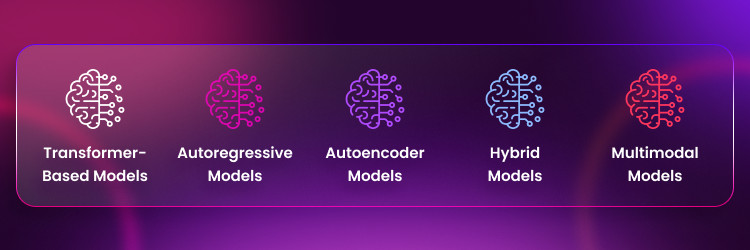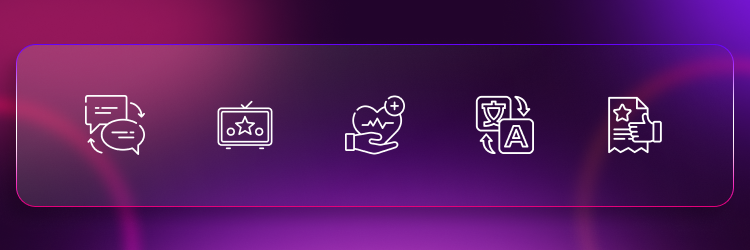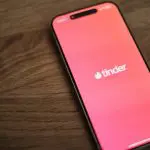 A Large Language Model (LLM) is a type of artificial intelligence that processes and generates text in a human-like way. Built using machine learning techniques, these models are trained on vast amounts of data. This helps them recognize patterns in language, making them valuable for natural language processing (NLP) tasks.
A Large Language Model (LLM) is a type of artificial intelligence that processes and generates text in a human-like way. Built using machine learning techniques, these models are trained on vast amounts of data. This helps them recognize patterns in language, making them valuable for natural language processing (NLP) tasks.
LLMs are crucial for improving conversational applications, such as chatbots and virtual assistants. Unlike earlier models, which worked word by word, LLMs process text sequences in parallel.
This helps LLMs understand the context and relationships between words, resulting in more coherent and human-like responses.Let’s discover what Large Language Models (LLMs) are, their applications, competitors, and the future of conversational AI!
What Are Large Language Models?
Large Language Models (LLMs) are advanced AI systems that generate human-like text. They use transformer architectures to understand complex language patterns. The models can handle tasks like answering questions, developing content, and translating text.
Unlike traditional machine learning models, LLMs don’t need specific programming for each task. Instead, they learn directly from the data. In the world of chatbots, this LLM ability to learn directly from data has seen the rise of AI girlfriend apps that mimic entire romantic relationships with users.
LLMs enable chatbots like AI girlfriends to keep track of conversations, interpret emotions, and respond in a human like manner.
A study by Yifan Yao and colleagues found that LLMs can improve tasks like code security.
Here is how LLMs differ from other AI technologies:
Machine Learning and Deep Learning
Machine learning is an AI that enables models to learn from data and make decisions. It allows systems to recognize patterns without needing to be explicitly programmed for each scenario. Traditional machine learning uses algorithms to predict outcomes or classify data.
Deep learning is a more advanced form of machine learning. It uses neural networks with multiple layers to understand complex patterns.
Deep learning plays a crucial role in LLM development. It handles unstructured data—like natural language—by extracting features through several layers. This makes it ideal for language tasks and supports LLMs in generating and interpreting text accurately.
Neural Networks
Neural networks are the foundation of many AI applications, including LLMs. They consist of layers of interconnected nodes called neurons. These neurons process input data and learn to identify patterns. Each layer extracts specific features from the input, gradually building an abstract understanding of the data in human language.
Different types of neural networks are optimized for specific tasks. Convolutional Neural Networks (CNNs) specialize in image processing. They identify features like edges, colors, and textures, making them highly effective for visual recognition.
Recurrent Neural Networks (RNNs), on the other hand, process sequential data like text or speech. RNNs retain information from previous steps. This helps them understand language and predict the next word.
Transformer Models
Transformers are the foundation behind most LLMs. They solve limitations in earlier neural networks using a self-attention mechanism. This mechanism helps the model understand context by focusing on word relationships in a sequence. Transformers do not process text sequentially but instead analyze entire sequences at once, leading to faster and more efficient language processing.
The self-attention mechanism helps transformers find the most relevant words in a sentence. By weighing the importance of each word, transformers generate more meaningful responses. This approach was a breakthrough in NLP, allowing models to understand context more deeply.
Prominent transformer-based models include BERT and GPT. BERT looks at the entire context to understand a sentence’s meaning. GPT generates coherent text based on prompts. These models significantly advance AI’s ability to understand and generate language.
LLMs use transformer-based architectures, which differ from traditional networks like RNNs. Transformers use a self-attention mechanism. This mechanism focuses on different parts of the input simultaneously. As a result, LLMs are more efficient and generate contextually accurate language.
Evolution of Large Language Models
The development of LLMs began in the 1990s with early statistical models. IBM’s alignment models were among the first to pioneer this field. In 2001, an n-gram model trained on 0.3 billion words achieved state-of-the-art results. By the 2000s, researchers used large web datasets to build these models. Statistical models dominated because they could handle extensive data effectively.
In 2012, advancements in neural networks marked a new era for LLMs. In 2016, Google adopted Neural Machine Translation. They used deep LSTM networks to improve translation accuracy. The turning point came in 2017 when Google introduced the transformer architecture in their paper “Attention Is All You Need.” Transformers used attention mechanisms to better understand language context. This made them more effective than earlier models.
In 2018, BERT was introduced, focusing on understanding text. Around the same time, GPT-1 became the first model in the GPT series. In 2019, GPT-2 gained attention for its impressive capabilities. GPT-3 followed in 2020 and became available through an API, expanding its reach. In 2022, ChatGPT brought LLM technology to the public and generated widespread media interest.
The release of GPT-4 in 2023 was another milestone. It introduced multimodal capabilities, processing both text and images. By 2024, models like BLOOM and LLaMA gained popularity as open and accessible alternatives. Despite these new options, GPT-4 remains one of the most powerful LLMs today, representing the peak of current technology.
How Do Large Language Models Work?
LLMs rely on transformer architecture and self-attention mechanisms to process relationships between words. The model uses an encoder for input and a decoder for output, making it versatile for many language tasks.
Training LLMs involves large datasets with billions of words from sources like books and websites. The model learns language patterns and uses them to predict what comes next in a sentence, creating contextually appropriate responses. This training requires high computing power, often using GPUs for faster processing.
Word embeddings represent words as vectors in a multi-dimensional space. This helps LLMs capture nuances in language by understanding how words relate to each other in context.
Self-attention also allows LLMs to process entire word sequences at once. This parallel approach helps them understand word connections, making the responses logical and context-aware. It’s why LLMs are effective in conversation, translation, and summarization tasks.
Types of Large Language Models
LLMs come in different forms, each suited for specific use cases or built with distinct architectures. These models vary in how they generate text, process inputs, or combine techniques to improve performance.
Let’s explore the main types of LLMs and highlight their unique features.
Transformer-Based Models
Transformer-based models are the foundation of most LLMs. They use a transformer architecture from 2017 and capture long-range relationships in text. A well-known transformer-based model is RoBERTa. It builds on BERT by optimizing the pre-training process.
Autoregressive Models
Autoregressive models generate text by predicting the next word in a sequence based on the previous words. They are trained to maximize the accuracy of the next word. GPT-3 is a popular autoregressive model. These models excel in producing fluent text. They can also produce repetitive or off-topic content. The major downside of these models is they need a lot of computing power.
Autoencoder Models
Autoencoder models use an encoder and a decoder to process text. The encoder condenses input into a latent space, a compact representation of the original text. The decoder then reconstructs or generates output from this encoded data. MarianMT is an example of an autoencoder model used for machine translation.
Autoencoder models effectively perform tasks like translation, summarization, and question answering.
Hybrid Models
Hybrid models combine features of different architectures to improve performance. Some models use transformers to understand the context. They also use RNNs to better capture sequences. This helps the model understand both long-term context and sequential dependencies. UniLM is an example of a hybrid model.
It merges autoregressive and sequence-to-sequence methods. This combination allows UniLM to handle various language tasks more effectively.
Multimodal Models
Multimodal models work with different input types, such as text and images. They can understand and generate content across multiple modalities. OpenAI’s CLIP is a good example of a multimodal model. It can associate text with images, making it useful for tasks like image captioning or text-based image searches.
Applications of Large Language Models
LLMs have many applications across industries. They power chatbots, enable content generation, and improve translation services. LLMs also automate tasks in customer service, education, and healthcare. Their ability to understand and generate text has made them valuable tools for communication.
LLMs are also used to write articles, provide technical support, and generate translations. These applications help businesses improve communication, increase efficiency, and create better user experiences.
Conversational AI
LLMs are the foundational technology driving conversational AI. This technology enables machines to engage in human-like dialogues through the use of natural language processing (NLP) and machine learning—LLMs power chatbots and virtual assistants, allowing these systems to comprehend user inquiries and respond naturally. An example of this is ChatGPT, which simulates realistic conversations.
In customer service, LLMs help answer common questions and reduce response times, improving customer satisfaction and allowing human agents to focus on more complex issues.
One common feature of most Conversational AI applications is an NSFW filter that limits the kind of conversations you can have by restricting the LLM from providing responses of an adult or erotic nature.
NSFW filters in traditional conversational AI applications have given rise to a sub-category of conversational AI that comes with no such filters, and targets users interested in a more mature themed conversation. These conversational AI apps are popularly referred to as NSFW AI apps. NSFW apps have the best user interaction metrics of all conversational AI. Candy AI for example boasts of an average user session duration of about 120 minutes (7200 seconds), which is way higher than the second LLM ChatGPT, which only has a user session duration of about 7 minutes (420 seconds).
Not Safe For Work (NSFW) LLMs are specifically designed to generate and engage with adult content, offering users a platform to explore complex desires and discussions surrounding sexuality, consent, and fantasy responsibly. These models acknowledge adult content as a legitimate aspect of human expression, catering to a diverse range of interests. Examples of such applications include NSFW AI platforms and sexting AI apps.
Text Generation and Content Creation
LLMs are commonly used for text generation and content creation. They write articles, scripts, product descriptions, and marketing copy. Tools like Claude and Llama 2 create original content suited to different needs. This is especially useful in marketing, publishing, and entertainment, where fast and engaging content is key.
LLMs help businesses create content quickly and efficiently. Marketing teams use LLMs to draft blog posts, ad copy, or even develop new ideas. This saves time and reduces costs, making content creation faster and more creative.
Code Generation and Debugging
LLMs also help with code generation and debugging. Models like GitHub Copilot suggest code snippets, generate functions, and assist in debugging. Developers can use natural language prompts, and the model generates the code. This makes coding faster and easier.
LLMs also help debug code by suggesting improvements. They support languages like Python, JavaScript, and SQL. This improves developers’ workflow and saves time.
Healthcare and Medical Research
In healthcare, LLMs help summarize medical literature and assist with patient interactions. Virtual health assistants use LLMs to provide health information and answer questions, freeing up time for healthcare professionals to focus on critical tasks.
LLMs also generate synthetic medical data for research. This helps researchers test models without using real patient data. By supporting healthcare professionals, LLMs help make healthcare more efficient and accessible.
Translation and Language Services
LLMs improve translation services by making translations more accurate. Platforms like Google Translate use LLMs to provide real-time translations. LLMs understand the context better than older models, which makes translations more meaningful.
Multilingual models help businesses communicate across languages. LLM-powered translators help companies reach global audiences effectively.
Personalization and Recommendations
LLMs are used for personalization in e-commerce and streaming services. They analyze user behavior to suggest products, movies, or content. Platforms like Netflix and Amazon use LLMs to recommend relevant items based on user preferences.
This personalization keeps users engaged by suggesting things they are likely to enjoy.
Key Competitors in the Large Language Model Space
Several key competitors are advancing AI technology in the large language model (LLM) space. OpenAI’s GPT models are among the most popular. GPT-3 and GPT-4 are widely known for setting new standards in natural language generation. These versatile models are used for content creation, chatbots, and more.
Google’s Bard is another major competitor. Bard is built on advanced LLM technology and works well with Google’s services. It is designed for conversational tasks, providing natural and informative responses. Google uses its vast data resources to make Bard a strong player in the LLM market.
Amazon has also entered the LLM space. Its language models are integrated with AWS (Amazon Web Services) and provide scalable AI services for businesses. Amazon focuses on customization, allowing companies to train models that fit their needs. Each competitor offers unique features, shaping the future of AI. To learn more, you can check Wikipedia and other tech resources for detailed insights.
Advantages and Disadvantages of Large Language Models
Large Language Models (LLMs) offer several benefits across different fields. In healthcare, they help medical professionals with administrative tasks. They also improve diagnostic accuracy and engage patients through virtual assistants. In education, LLMs create educational content and improve student engagement. They also personalize learning experiences to fit each student’s needs. In business, LLMs automate processes, making operations more efficient.
LLMs also enhance user interactions. LLM-powered chatbots answer customer queries and provide support 24/7. They improve the customer experience and reduce wait times. LLMs also assist in content creation. They help businesses generate marketing content, product descriptions, and more. This saves time and cuts costs, allowing teams to focus on creative work.
However, LLMs have disadvantages too. One major issue is bias in the model’s output. LLMs learn from large datasets, which may contain biases. As a result, their responses can also be biased. There is also the risk of misinformation. LLMs may not always distinguish between real and fake information. This makes human oversight essential to ensure accuracy.
Another downside is the high computational cost of LLMs. Training them requires a lot of computing power, which is expensive. There are also ethical concerns about privacy and misuse. LLMs can generate harmful content if used improperly. Ensuring responsible and ethical use is essential to address these risks.
Best Practices for Using LLMs
To use Large Language Models (LLMs) effectively, it is essential to follow best practices. These practices help protect user data, reduce biases, and ensure responsible deployment. Below are some essential guidelines to consider when using LLMs.
Data Privacy Considerations
Data privacy is crucial when using LLMs. Protecting user data should be a top priority. It is important to avoid storing sensitive information unnecessarily. Encrypting data before feeding it into an LLM helps secure user information. Users should also be informed about how their data will be used. Limiting data collection to what is needed can further reduce privacy risks.
Bias Mitigation
LLMs can sometimes generate biased outputs. This happens because the models learn from datasets that may contain biases. To mitigate bias, it is essential to use diverse and well-balanced datasets for training. Regular reviews of the model’s responses can help identify and reduce biases. Fine-tuning LLMs with specific datasets representing different groups can improve fairness in the generated outputs.
Responsible Deployment
Responsible deployment is key to using LLMs ethically. These models should not be used for harmful purposes or to spread misinformation. It is essential to monitor how LLMs are used and put limits on sensitive applications.
Developers should always consider the impact of LLMs on users. Clear guidelines should be established for when and how LLMs are applied, ensuring they are used to benefit people rather than harm them.
Natural Language Processing (NLP) and LLM
Large Language Models (LLMs) are widely used in Natural Language Processing (NLP). They power applications like sentiment analysis, text summarization, and automatic translation. Sentiment analysis helps understand user emotions by analyzing text.
Text summarization condenses long articles into shorter versions. Automatic translation allows for real-time translations between different languages. LLMs make these tasks faster and more accurate by understanding complex language patterns.
LLMs are effective because they understand the context of language. The transformer model plays a key role in this. It mimics certain aspects of the human brain by focusing on important input parts. Understanding context is crucial for tasks like translation. The meaning of words can change based on how they are used.
For example, LLMs can determine whether a word has a positive or negative meaning based on context. This ability ensures more precise communication across different languages and settings. It also helps businesses understand user needs better and provide better services.
How Developers Can Start Creating LLMs
Step 1: Understanding the Basics of LLMs
To start creating an LLM, developers need to understand the basics of machine learning and deep learning. It is also crucial to learn about transformer models. Transformer models are the backbone of most LLMs, allowing them to handle large amounts of text effectively.
Developers should study key concepts like NLP, word embeddings, and self-attention. These concepts help in building LLMs that can understand and generate human-like text.
Step 2: Gathering and Preprocessing Data
The next step is to gather data for training. LLMs need large datasets to learn well. Developers can collect data from sources like books, articles, and websites. Preprocessing the data is important. It includes cleaning the text, removing errors, and tokenizing it into smaller parts.
Data must be converted into word embeddings. These are numerical representations that the model can understand. Proper data preparation is key to helping the model learn effectively.
Step 3: Choosing and Training the Model
After data preparation, developers need to choose the model. The transformer model is popular. Its self-attention feature helps it understand word relationships. Developers can create the model using frameworks like TensorFlow or PyTorch.
Training the LLM means feeding it large amounts of data and adjusting it to minimize errors. This step needs a lot of computing power, usually GPUs or TPUs. Training time depends on the dataset size and model complexity.
Step 4: Fine-Tuning and Deployment
Once the model is trained, developers should fine-tune it for specific tasks. Fine-tuning involves training the model again on a smaller, specialized dataset. This makes it more accurate for certain tasks, like question answering or text summarization.
After fine-tuning, the model is ready for deployment. It can be deployed using cloud platforms or other hosting solutions. Developers should keep monitoring the model to ensure it works correctly. Adjustments may be needed over time to maintain performance and reliability.
FAQs on Large Language Models
What Does LLM Mean in AI?
LLM stands for “large language model.” It is a type of machine learning or deep learning model. LLMs perform many natural language processing (NLP) tasks, including translating, classifying, and generating text. They can also answer questions conversationally and recognize data patterns.
Is ChatGPT an LLM?
Yes, ChatGPT is a type of LLM. It was developed by OpenAI using advanced natural language processing. ChatGPT understands user questions and responds in a conversational style. It is based on the transformer architecture, which uses self-attention to understand context. This allows ChatGPT to provide coherent and relevant answers.
What Is the Difference Between GPT and LLM?
LLM is a broad term for any model that can perform natural language tasks, including translating, summarizing, and generating text. LLMs can be developed by any organization and may use different architectures. GPT stands for “Generative Pre-trained Transformer.”
It is a type of LLM made by OpenAI. GPT models, like GPT-3 and GPT-4, are optimized for text generation. They are based on the transformer architecture and use self-attention to understand the context of the text. While all GPT models are LLMs, not all LLMs are GPT. GPT is a specific series that focuses on generating text efficiently.
What Is LLM Harvard?
At Harvard University, LLM refers to the “Master of Laws” degree. It is a one-year graduate program for legal professionals. This program attracts people from many backgrounds. They include lawyers, judges, diplomats, and activists. Harvard’s LLM has nothing to do with large language models in AI.
Instead, it focuses on advanced legal education, helping legal professionals expand their skills in various areas of law.
Conclusion on Large Language Models
LLMs have significantly impacted artificial intelligence. They have transformed how we interact with technology, enabling more natural communication between people and machines. LLMs enhance user engagement through conversational AI and support developers, educators, and businesses. Their versatility drives AI solutions and fosters automation across industries.
However, LLMs face challenges, with ethical concerns being a priority. Data privacy, reducing bias and ensuring responsible use are critical issues. Careful oversight is needed to prevent misuse and limit bias. By following best practices, we can harness LLMs responsibly for society’s benefit.




















